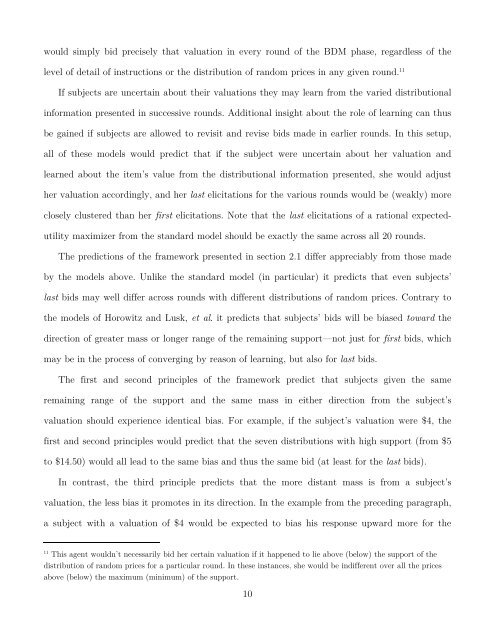Testing Distributional Dependence in the Becker-DeGroot-Marschak ...
Testing Distributional Dependence in the Becker-DeGroot-Marschak ...
Testing Distributional Dependence in the Becker-DeGroot-Marschak ...
You also want an ePaper? Increase the reach of your titles
YUMPU automatically turns print PDFs into web optimized ePapers that Google loves.
would simply bid precisely that valuation <strong>in</strong> every round of <strong>the</strong> BDM phase, regardless of <strong>the</strong><br />
level of detail of <strong>in</strong>structions or <strong>the</strong> distribution of random prices <strong>in</strong> any given round. 11<br />
If subjects are uncerta<strong>in</strong> about <strong>the</strong>ir valuations <strong>the</strong>y may learn from <strong>the</strong> varied distributional<br />
<strong>in</strong>formation presented <strong>in</strong> successive rounds. Additional <strong>in</strong>sight about <strong>the</strong> role of learn<strong>in</strong>g can thus<br />
be ga<strong>in</strong>ed if subjects are allowed to revisit and revise bids made <strong>in</strong> earlier rounds. In this setup,<br />
all of <strong>the</strong>se models would predict that if <strong>the</strong> subject were uncerta<strong>in</strong> about her valuation and<br />
learned about <strong>the</strong> item’s value from <strong>the</strong> distributional <strong>in</strong>formation presented, she would adjust<br />
her valuation accord<strong>in</strong>gly, and her last elicitations for <strong>the</strong> various rounds would be (weakly) more<br />
closely clustered than her first elicitations. Note that <strong>the</strong> last elicitations of a rational expected-<br />
utility maximizer from <strong>the</strong> standard model should be exactly <strong>the</strong> same across all 20 rounds.<br />
The predictions of <strong>the</strong> framework presented <strong>in</strong> section 2.1 differ appreciably from those made<br />
by <strong>the</strong> models above. Unlike <strong>the</strong> standard model (<strong>in</strong> particular) it predicts that even subjects’<br />
last bids may well differ across rounds with different distributions of random prices. Contrary to<br />
<strong>the</strong> models of Horowitz and Lusk, et al. it predicts that subjects’ bids will be biased toward <strong>the</strong><br />
direction of greater mass or longer range of <strong>the</strong> rema<strong>in</strong><strong>in</strong>g support—not just for first bids, which<br />
may be <strong>in</strong> <strong>the</strong> process of converg<strong>in</strong>g by reason of learn<strong>in</strong>g, but also for last bids.<br />
The first and second pr<strong>in</strong>ciples of <strong>the</strong> framework predict that subjects given <strong>the</strong> same<br />
rema<strong>in</strong><strong>in</strong>g range of <strong>the</strong> support and <strong>the</strong> same mass <strong>in</strong> ei<strong>the</strong>r direction from <strong>the</strong> subject’s<br />
valuation should experience identical bias. For example, if <strong>the</strong> subject’s valuation were $4, <strong>the</strong><br />
first and second pr<strong>in</strong>ciples would predict that <strong>the</strong> seven distributions with high support (from $5<br />
to $14.50) would all lead to <strong>the</strong> same bias and thus <strong>the</strong> same bid (at least for <strong>the</strong> last bids).<br />
In contrast, <strong>the</strong> third pr<strong>in</strong>ciple predicts that <strong>the</strong> more distant mass is from a subject’s<br />
valuation, <strong>the</strong> less bias it promotes <strong>in</strong> its direction. In <strong>the</strong> example from <strong>the</strong> preced<strong>in</strong>g paragraph,<br />
a subject with a valuation of $4 would be expected to bias his response upward more for <strong>the</strong><br />
11 This agent wouldn’t necessarily bid her certa<strong>in</strong> valuation if it happened to lie above (below) <strong>the</strong> support of <strong>the</strong><br />
distribution of random prices for a particular round. In <strong>the</strong>se <strong>in</strong>stances, she would be <strong>in</strong>different over all <strong>the</strong> prices<br />
above (below) <strong>the</strong> maximum (m<strong>in</strong>imum) of <strong>the</strong> support.<br />
10


